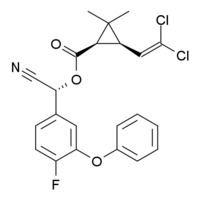Formula C22H18Cl2FNO3 | ||
 | ||
Cyfluthrin is a pyrethroid insecticide and common household pesticide. It is a complex organic compound and the commercial product is sold as a mixture of isomers. Like most pyrethroids, it is highly toxic to fish, invertebrates, and insects, but it is far less toxic to humans. It is generally supplied as a 10-25% liquid concentrate for commercial use and is diluted prior to spraying onto agricultural crops and outbuildings.
Contents
Safety
In rats, the LD50s are 500, 800 (oral), and 600 (skin) mg/kg.
Excessive exposure can cause nausea, headache, muscle weakness, salivation, shortness of breath and seizures. In humans, it is deactivated by enzymatic hydrolysis to several carboxylic acid metabolites, whose urinary excretion half-lives are in a range of 5–7 hours. Worker exposure to the chemical can be monitored by measurement of the urinary metabolites, while severe overdosage may be confirmed by quantification of cyfluthrin in blood or plasma.
Health and safety risks are controlled by right to know laws that exist in most developed countries. Cyfluthrin is regulated in the US by the EPA.
Commercial use
Cyfluthrin is used in insecticidal sprays such as Temprid (Bayer) which uses a combination of (beta-) cyfluthrin and imidacloprid.
